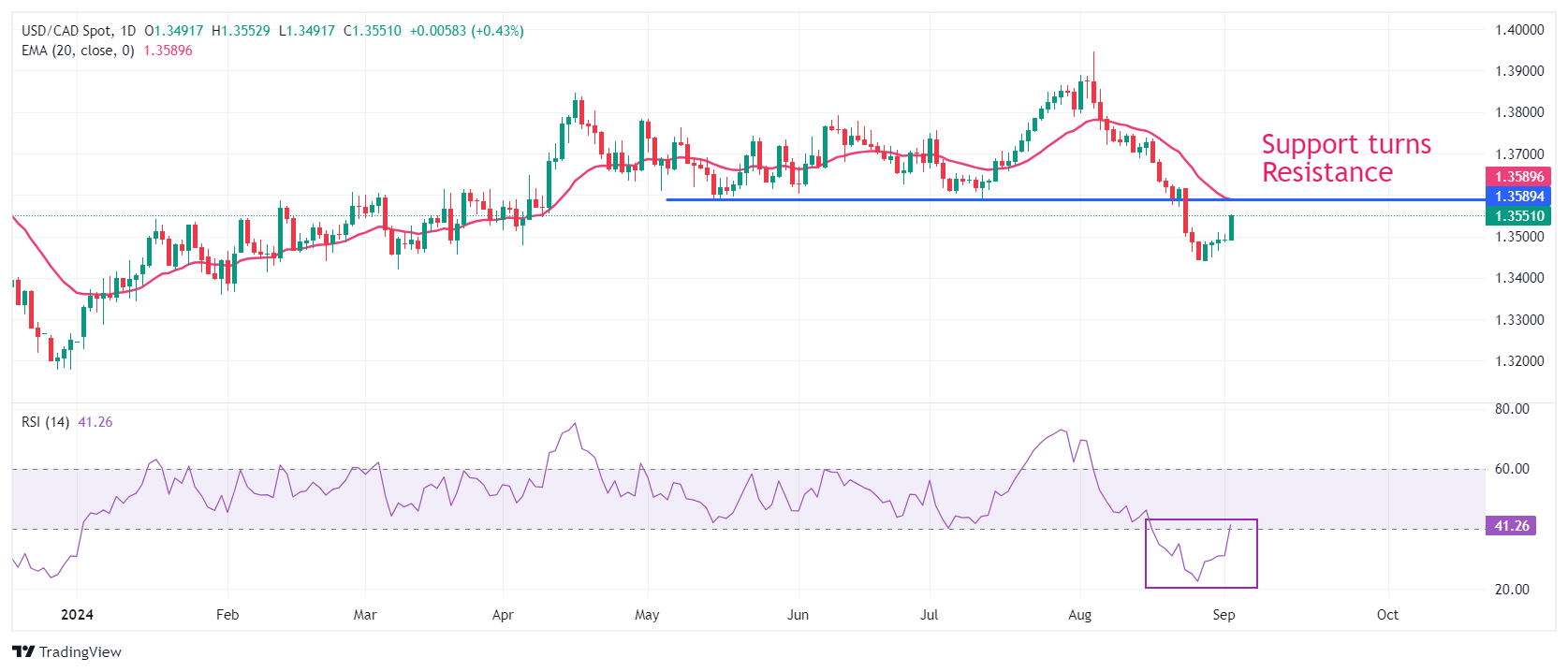- USD/CAD rises near 1.3550 as Canadian dollar weakens ahead of BoC policy meeting.
- US Dollar gives back intraday gains with US NFP in focus.
- The US ISM manufacturing PMI contracted again in August.
The USD/CAD pair is up near 1.3550 in the North American session on Tuesday. The Loonie asset is gaining sharply as the Canadian Dollar (CAD) weakens amid uncertainty ahead of the Bank of Canada (BoC) monetary policy meeting, which is set to be announced on Wednesday.
Investors see the BoC cutting interest rates again by 25 basis points (bps) to 4.25%. This would be the third consecutive interest rate cut due to easing price pressures, economic slowdown and downside risks to the labor market.
The US Dollar (USD) is giving back its intraday gains with investors focused on the US (US) Non-Farm Payrolls (NFP) data for August due on Friday which will weigh on market speculation on Federal Reserve (Fed) interest rate cuts.
Meanwhile, the US ISM has reported weaker than expected manufacturing PMI data for August. The report showed that activities contracted at a slower pace, with the PMI coming in at 47.2, below estimates of 47.5 but higher than the previous release of 46.8.
The USD/CAD is bouncing strongly after a V-shaped recovery from a fresh five-month low of 1.3440 on a daily time frame. The asset is expected to extend its recovery near the horizontal resistance drawn from the May 15 low of 1.3590, which used to be a key support for the US Dollar bulls.
The sloping 20-day exponential moving average (EMA) near 1.3590 suggests that the short-term trend is bearish. The 14-day relative strength index (RSI) is bouncing strongly after turning oversold near 22.50. The move suggests that the bearish momentum is over for now, however, the overall trend remains bearish.
A further pullback of the May 15 low of 1.3590 is likely to be a selling opportunity for market participants, which would drag the asset towards the April 5 low of 1.3540, followed by the psychological support of 1.3500.
On the other hand, an upside recovery above the August 21 high of 1.3626 would propel the asset towards the August 19 high of 1.3687 and the August 15 high of 1.3738.
USD/CAD daily chart
Canadian Dollar FAQs
The key factors determining the Canadian dollar (CAD) are the level of interest rates set by the Bank of Canada (BoC), the price of oil, Canada’s main export, the health of its economy, inflation and the trade balance, which is the difference between the value of Canadian exports and its imports. Other factors include market sentiment, i.e. whether investors are betting on riskier assets (risk-on) or looking for safe assets (risk-off), with risk-on being positive for the CAD. As its largest trading partner, the health of the US economy is also a key factor influencing the Canadian dollar.
The Bank of Canada (BoC) exerts significant influence over the Canadian dollar by setting the level of interest rates that banks can lend to each other. This influences the level of interest rates for everyone. The BoC’s main objective is to keep inflation between 1% and 3% by adjusting interest rates up or down. Relatively high interest rates are generally positive for the CAD. The Bank of Canada can also use quantitative easing and tightening to influence credit conditions, with the former being negative for the CAD and the latter being positive for the CAD.
The price of oil is a key factor influencing the value of the Canadian dollar. Oil is Canada’s largest export, so the price of oil tends to have an immediate impact on the value of the CAD. Generally, if the price of oil rises, the CAD rises as well, as aggregate demand for the currency increases. The opposite occurs if the price of oil falls. Higher oil prices also tend to lead to a higher probability of a positive trade balance, which also supports the CAD.
Although inflation has traditionally always been considered a negative factor for a currency, as it reduces the value of money, the opposite has actually occurred in modern times, with the relaxation of cross-border capital controls. Higher inflation typically leads central banks to raise interest rates, which attracts more capital inflows from global investors looking for a lucrative place to store their money. This increases demand for the local currency, which in Canada’s case is the Canadian dollar.
The released macroeconomic data measures the health of the economy and can have an impact on the Canadian Dollar. Indicators such as GDP, manufacturing and services PMIs, employment and consumer confidence surveys can influence the direction of the CAD. A strong economy is good for the Canadian Dollar. Not only does it attract more foreign investment, but it can encourage the Bank of Canada to raise interest rates, which translates into a stronger currency. However, if the economic data is weak, the CAD is likely to fall.
Source: Fx Street
I am Joshua Winder, a senior-level journalist and editor at World Stock Market. I specialize in covering news related to the stock market and economic trends. With more than 8 years of experience in this field, I have become an expert in financial reporting.






